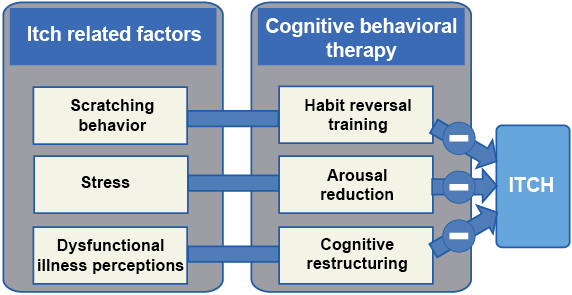
Habit Reversal Therapy For Tourette’s Syndrome
Habit reversal therapy is an effective treatment for body-focused repetitive behaviors like excoriation disorder (skin picking) and trichotillomania (hair pulling). It also helps individuals manage their tics, which are sudden, involuntary movements or sounds.
During sessions, clients build awareness of the unconscious behaviors and learn to recognize physical cues that precede their unwanted behavior. They then practice competing responses to the behavior.
It is a form of behavioral therapy
Habit reversal training, also known as HRT, is an effective treatment for Tourette’s and other tic disorders. It helps people become more aware of their unconscious behaviors and trains them to act differently. It has been around since the 1970s, but a recent surge in clinical evidence has brought it back into prominence as a treatment for tic disorders.
The first step in HRT is awareness training, where participants are taught to recognize the physical cues that precede the tic or behavior. They are then encouraged to find a competing response to replace the unwanted behavior. This can be as simple as reaching up to the head and stroking the hair, or as complex as learning relaxation techniques. It’s important to practice the new behavior outside of the therapy session so that it can be used in a variety of situations and environments.
Once a person becomes more aware of the triggers for their tics and habits, they can work with a therapist to develop a competing response. The therapist will help the person choose a new, incompatible behavior and encourage them to perform it when the triggers for the old behavior occur. This can be extremely challenging, but with time, it is possible to completely overcome the unwanted behavior.
Some people who struggle with tics and other uncontrollable habits experience embarrassment, shame, or feelings of powerlessness over their behavior. These feelings can contribute to the development of other mental health conditions such as anxiety and depression. Others may even feel that their tics and habits are damaging their appearance. For example, hair pulling can lead to baldness, while skin picking can leave scabs and scars.
The goal of habit reversal therapy is to change the person’s negative beliefs about their tics and habits. This is accomplished through the use of a combination of different therapies, including motivational interviewing and skill-based groups. It is also important to increase the person’s self-efficacy by encouraging them to use the new skills and strategies in different settings. This can reduce the fear of social stigma associated with these conditions and improve their quality of life.
It is used to treat Tourette’s syndrome
Habit Reversal Training (HRT) is one of the most well-studied and effective types of behavioral therapy for Tourette’s syndrome. It involves a multi-component behavior treatment package that suppresses nervous habits and tics by introducing an incompatible response. This response functions as a self-administered punishment and has been shown to reduce tic frequency in people with Tourette’s. HRT focuses on teaching patients how to notice when they are having a tic and then replacing it with the incompatible response. The goal of the HRT treatment is to decrease tics and improve quality of life.
It’s important for children and teens to be involved in this type of behavioral therapy, as it will help them learn how to manage their tics and habits. They will also need to be supported and encouraged by their friends and family, as they practice their new behaviors. Some children will experience a reduction in their tics and habits within days, while others may take a few months to see the benefits of their new skills.
A psychologist who specializes in habit reversal therapy is usually trained in the use of the Comprehensive Behavioral Intervention for Tics (CBIT) model of treatment, which includes habit reversal training and exposure response prevention (ERP). ERP is a similar form of behavioral therapy that has been used to treat body-focused repetitive behaviors like skin picking and trichotillomania. It helps the person to tolerate the feeling of urges that occur before a tic and resist it. It can be an uncomfortable sensation to start, but with time the person will begin to resist it for longer periods of time.
In addition to the habit reversal techniques, the therapist will work with the patient to identify possible triggers of their tics. They will then recommend changes to the environment and other strategies to prevent tics. They will also teach the patient to replace the tic with another behavior that is compatible with the situation.
The therapist will also encourage the patient to give positive feedback to themselves and their loved ones when they see a difference in their tics and habits. This will help them build motivation and encourage them to continue their treatment plan.
It is a form of cognitive behavioral therapy
Habit reversal therapy, also known as habit reversal training, is a behavioral treatment that can help reduce the frequency of tics and other nervous habits. It helps clients to become aware of their unconscious actions and learn how to control them. This behavior-changing treatment is particularly effective for tics associated with Tourette’s syndrome and other related disorders, such as nail biting, thumb sucking and skin picking. It has also been shown to be effective for anxiety, depression and procrastination.
The treatment focuses on identifying the involuntary movements or sounds that precede a tic and replacing them with something else. For example, a client may be taught to cough or take deep breaths in place of the tics that would otherwise occur. It is usually done in outpatient sessions with a psychiatrist or psychologist, and can be completed in eight to 16 weekly treatments. The therapist will be able to determine the best plan for your child based on their specific needs.
This therapy has been used since the 1970s and has been the subject of many studies. In addition to reducing tics, it has also been found to be effective in treating other disorders, including excoriation (skin-picking disorder) and trichotillomania (hair-pulling), as well as other impulse control problems, such as addiction.
Several different techniques have been used in the past to treat tics and other nervous behaviors, but none have been more successful than habit reversal therapy. It is especially useful for children and adolescents who suffer from Tourette’s syndrome, because it is less invasive than pharmacological interventions. It is also highly cost-effective and can be performed in a clinical setting, unlike other forms of therapy.
It is important for the person receiving this treatment to be willing to participate in it. If they do not, it will be difficult to overcome the unwanted behavior. They should also be willing to practice the new skills in a variety of situations. This will help them to transfer the medical setting’s “safe” experience into their everyday lives. It is also recommended that they share their successes with friends and family to reinforce the positive changes.
It is a form of hypnosis
If you struggle with an unwanted habit, whether it’s biting your nails or picking your skin, hypnosis can help you break the cycle. During a session, a therapist will guide you into a state of relaxation (hypnosis). They’ll then use positive suggestions to reinforce changes in your behavior. They’ll also teach you relaxation techniques such as deep breathing, mental imaging and progressive muscle relaxation.
Tics and habits are often uncontrollable, but they can cause a variety of problems such as nail infections, bald patches or self-esteem issues. Hypnosis can help you overcome these problems and eliminate your habit for good.
This form of therapy was originally developed to treat Tourette’s syndrome and other nervous tics. More recently, it has been shown to be effective for other compulsive behaviors like trichotillomania and skin picking. It is an outpatient treatment that typically lasts about 8 to 16 weeks.
During this type of therapy, clients learn to recognize the frequency of their tics and habits. They also learn to develop a competing response that prevents the unwanted behavior from occurring. This technique is especially effective for children who are unable to control their tics with other strategies such as medication.
In this form of hypnosis, the patient is taught to focus on a different activity when they feel the urge to perform their tic or habit. They may practice this new activity until it becomes automatic. During this process, they are encouraged to ask for support from family and friends. They are also encouraged to make a list of problems caused by the unwanted behaviour so they can remember why it’s important to break the habit.
During a hypnosis session, the client will be guided into a deeply relaxed and calm state of mind that makes them more open to suggestion. They’ll be asked to picture themselves in a typical situation where the old habit would occur. The therapist will then ask them to really engage their imagination and notice all the details of this environment, including the colors and shapes around them. The therapist will then replace the old habit with a different activity that meets the same need.





